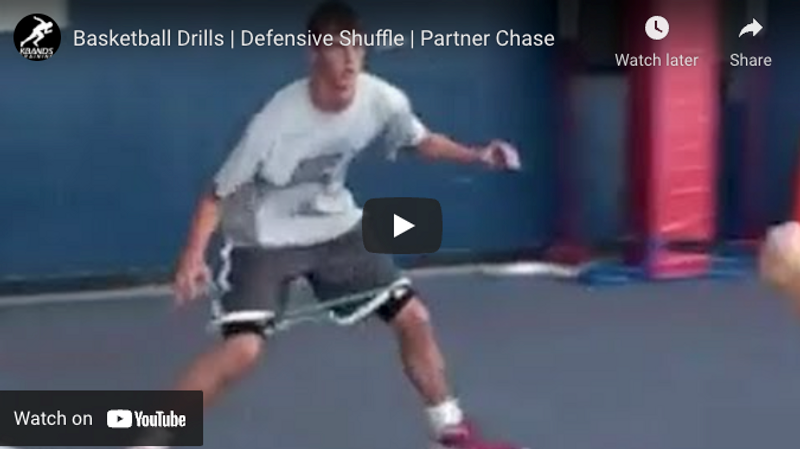Increase Your Speed on Defense | Basketball
Effective basketball defense maneuvers require strength in several key muscle groups, but they also require situational awareness, fast reflexes, and strong hand-eye coordination. In order to take a basketball defense strategy to the next level, it’s a good idea to perform drills and maneuvers that exercise both strength and skills at the same time.
But first, what skills and strengths are required to increase speed and elevate both team and personal defense? Here are a few key focus areas.
1. Leg strength: defense positions are often low and stable, which means they depend on strong quads, strong hamstrings, and power in the core. While in a lowered position with high tension in the quads, basketball players still need to maneuver quickly across the court. In the video below, the basketball players will execute a shuffling exercise that will help them increase speed while staying balanced and in control.
2. Speed while dribbling: Maintaining high speed and ball control at the same time takes practice. Running drills, both with and without the ball, can help a defense player keep up with a running partner as he or she moves across the court.
Passing speed and accuracy: Passing drills and running drills are both core aspects of solid defense. Exercises like those in the video can help basketball players increase ball handling speed while staying low and strong in the core.
Powerful Defense: Basketball Drills for Speed and Control
In the video embedded below, Trevor Theismann of Kbandstraining.com leads a group of athletes through a set of partner-based defense drills. Notice that the basketball players are wearing Kbands resistance training bands attached securely to their upper legs. These bands provide additional tension that can support training goals and help athletes gain strength in the quads, hamstrings, hip flexors and core. The bands are attached with secure straps and positioned so the long band connects the legs at the back and the short band connects in the front.
When they’re ready to begin the first defense drill, the basketball players have already warmed up and are prepared to control their technique and position to gain explosiveness.
Defense Drills: Defensive Shuffle
To gain the benefits of the first defense drill, basketball players should focus and body position and control over speed. Like the athletes in the video, basketball players should drop down in the core and position their body weight in their upper legs. This is followed by a shuffling lateral motion down the court in which the legs stay wide, the body stays low, and the feet never come in contact.
As two partners complete this move facing each other and shuffling in a parallel motion, they should pass the ball back and forth at chest level. If executed correctly, this defense move should challenge hand-eye coordination, body control in the lower core, and the athlete’s ability to maintain awareness and focus on more than one skill simultaneously. Watch how the athletes in the video stay low and work to keep their feet and knees apart during the move.
After completing the first defense drill, the basketball players move to the side of the court and begin a partner chase exercise. One partner gains a head start and runs down the court without a ball. The second partner pursues while keeping the basketball under control. As in the earlier defense drill, the Kbands add an element of challenge to the move for both partners, since they tighten the running stride and increase tension in the hamstrings and quads.
Defense Drills: Side Shuffle with No Basketball
Now the basketball players return to the center of the court and repeat the first part of the defense drill, but this time they increase speed and leave the basketballs on the side line. With their hands free, they can focus fully on maintaining speed and control in the legs and lower core. Once again, note how they work to keep their body positions low and their knees far apart, even as they increase speed.
Defense Drills: Partner Chase with No Basketball
As the basketball players finish the first defense drill, they move to the wall again for a repeat of the partner chase exercise. But this time they can increase speed since they aren’t using a ball during the drill. Instead, one partner runs down the line and the other runs to keep pace, while both of them work against the resistance of the Kbands. The basketball players maximize the benefits of the drill if they increase speed quickly and maintain control at the beginning and end of the track.
Defense Drills: Final Notes
One of the most important aspects of a tight defense during any game situation is the body’s ability to maintain control while basketball players increase speed. A strong defense play involves a low body position that can move laterally at very high speed without losing balance, which can easily happen if the feet get too close together. Also, when the feet and knees move into toward the centerline, the body position tends to rise up, and a strong defensive stance should stay low and should always be built on a stable base.
As you watch the video, pay close attention to the body positions of the players who seem the most stable, light-footed, and fast during the side-to-motion across the court. Note the control they maintain over their arm motion as well as the path of their feet. As basketball players and teams complete this drill on their own courts, they should monitor each other’s body position and help each other stay low and controlled. Coaches and players should observe the progress of all team members, both while passing the ball and while moving through the drills with hands free.

